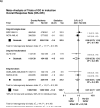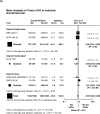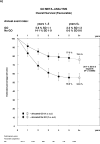Addition of gemtuzumab ozogamicin to induction chemotherapy in adult patients with acute myeloid leukaemia: a meta-analysis of individual patient data from randomised controlled trials
- PMID: 25008258
- PMCID: PMC4137593
- DOI: 10.1016/S1470-2045(14)70281-5
Addition of gemtuzumab ozogamicin to induction chemotherapy in adult patients with acute myeloid leukaemia: a meta-analysis of individual patient data from randomised controlled trials
Abstract
Background: Gemtuzumab ozogamicin was the first example of antibody-directed chemotherapy in cancer, and was developed for acute myeloid leukaemia. However, randomised trials in which it was combined with standard induction chemotherapy in adults have produced conflicting results. We did a meta-analysis of individual patient data to assess the efficacy of adding gemtuzumab ozogamicin to induction chemotherapy in adult patients with acute myeloid leukaemia.
Methods: We searched PubMed for reports of randomised controlled trials published in any language up to May 1, 2013, that included an assessment of gemtuzumab ozogamicin given to adults (aged 15 years and older) in conjunction with the first course of intensive induction chemotherapy for acute myeloid leukaemia (excluding acute promyelocytic leukaemia) compared with chemotherapy alone. Published data were supplemented with additional data obtained by contacting individual trialists. The primary endpoint of interest was overall survival. We used standard meta-analytic techniques, with an assumption-free (or fixed-effect) method. We also did exploratory stratified analyses to investigate whether any baseline features predicted a greater or lesser benefit from gemtuzumab ozogamicin.
Findings: We obtained data from five randomised controlled trials (3325 patients); all trials were centrally randomised and open label, with overall survival as the primary endpoint. The addition of gemtuzumab ozogamicin did not increase the proportion of patients achieving complete remission with or without complete peripheral count recovery (odds ratio [OR] 0·91, 95% CI 0·77-1·07; p=0·3). However, the addition of gemtuzumab ozogamicin significantly reduced the risk of relapse (OR 0·81, 0·73-0·90; p=0·0001), and improved overall survival at 5 years (OR 0·90, 0·82-0·98; p=0·01). At 6 years, the absolute survival benefit was especially apparent in patients with favourable cytogenetic characteristics (20·7%; OR 0·47, 0·31-0·73; p=0·0006), but was also seen in those with intermediate characteristics (5·7%; OR 0·84, 0·75-0·95; p=0·005). Patients with adverse cytogenetic characteristics did not benefit (2·2%; OR 0·99, 0·83-1·18; p=0·9). Doses of 3 mg/m(2) were associated with fewer early deaths than doses of 6 mg/m(2), with equal efficacy.
Interpretation: Gemtuzumab ozogamicin can be safely added to conventional induction therapy and provides a significant survival benefit for patients without adverse cytogenetic characteristics. These data suggest that the use of gemtuzumab ozogamicin should be reassessed and its licence status might need to be reviewed.
Funding: None.
Copyright © 2014 Elsevier Ltd. All rights reserved.
Figures












Comment in
-
A new dawn for gemtuzumab ozogamicin?Lancet Oncol. 2014 Aug;15(9):913-4. doi: 10.1016/S1470-2045(14)70289-X. Epub 2014 Jul 6. Lancet Oncol. 2014. PMID: 25008259 No abstract available.
References
-
- Bross PF, Beitz J, Chen G, et al. Approval Summary: Gemtuzumab Ozogamicin in Relapsed Acute Myeloid Leukemia. Clin. Cancer Res. 2001;7:1490–1496. - PubMed
-
- Larson RA, Boogaerts M, Estey E, et al. Antibody-targeted chemotherapy of older patients with acute myeloid leukemia in first relapse using Mylotarg (gemtuzumab ozogamicin). Leukemia. 2002;16:1627–1636. - PubMed
-
- Giles FJ, Kantarjian HM, Kornblau SM, et al. Mylotarg (gemtuzumab ozogamicin) therapy is associated with hepatic venoocclusive disease in patients who have not received stem cell transplantation. Cancer. 2001;92:406–413. - PubMed
-
- Kell WJ, Burnett AK, Chopra R, et al. A feasibility study of simultaneous administration of gemtuzumab ozogamicin with intensive chemotherapy in induction and consolidation in younger patients with acute myeloid leukemia. Blood. 2003;102:4277–4283. - PubMed
-
- Burnett AK, Hills RK, Milligan D, et al. Identification of Patients With Acute Myeloblastic Leukemia Who Benefit From the Addition of Gemtuzumab Ozogamicin: Results of the MRC AML15 Trial. J. Clin. Oncol. 2011;29:369–377. - PubMed
Publication types
MeSH terms
Substances
Grants and funding
LinkOut - more resources
Full Text Sources
Other Literature Sources
Medical

